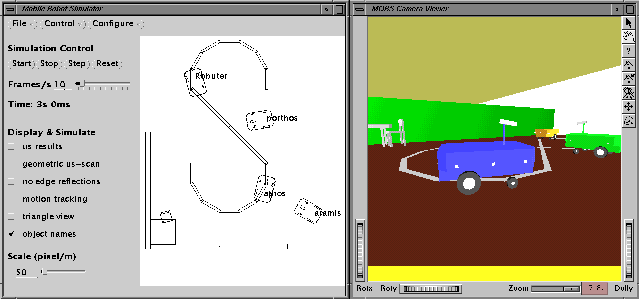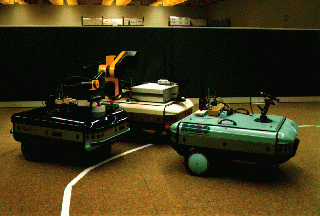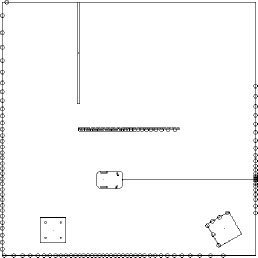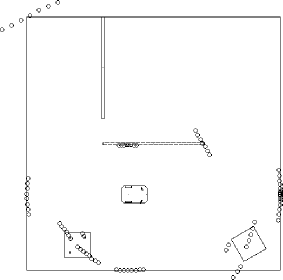MOBS - Mobile Robot Simulator

Description
MOBS is a fully 3-dimensional simulation system for mobile robot systems.
The simulator understands the same ASCII sequences as the "Robuter II" robot
The simulator can be connected to a robot application program
even without re-compilation of the application program.
Sensors modeled are:
- odometry
- bumpers
- sonar sensors
- camera view (using the SGI's Inventor library)
The sonar simulation images demonstrate the difference between an
ideal measurement vs. the geometrical sonar simulation.
Markings indicate an assumed obstacle.
MOBS has a complex sonar model, including multiple reflections,
intensity calculations, and noise, which reflects
real world behavior. Note the "false" sonar reading
in the compute-intense geometrical simulation.
MOBS was designed and implemented by Horst Stolz under direction of
Thomas Bräunl.
It uses the PVM tool to connect Sun and SGI workstations and the MasPar.
The DRI (distributed robot interface, implemented by Alexander Rausch),
is provides basic communication routines between robots or between robot
and simulator.
MOBS is part of the CoMoRoS project (Cooperative Mobile
Robot Systems Stuttgart), which has been directed
by Thomas Bräunl at the Univ. Stuttgart, Germany.
The goals of project CoMRoS are the generation of a software architecture
for groups of cooporating autonomous mobile robots as well as the implementation
of applications in factory and traffic environments.
Applications included:
- following road markings, autonomous cars in highway traffic,
"autobahn autopilot"
- planning and coordination of multiple autonomous agents in factory
environments
- convoy driving, autonomous trucks
Hardware
We are using the "Robuter" autonomous robot systems, manufactured by Robosoft
S.A. in Bayonne, France. The vehicles are about 80cm x 100cm in size and
weigh about 150kg. The vehicle has an onboard VME computer system and can
be controlled via an 9600 Baud RS-232 line by high level ASCII commands.
Each vehicle has a belt of up to 24 sonar sensors. We have camera systems
on all vehicles and use remote transmissions for images (analog) and data
(digital) to avoid cables.
Since the three robots came from France, we called them Porthos, Athos,
and Aramis after Dumas story of the three Musketeers. Aramis has a 6dof
manipulator and Athos has a 4dof stereo camera head.
As front end computer systems, we use a Sun SPARCstation 10 for each
robot. In addition we use an ELTEC VectEx VME subsystem, which allows image
processing in real time. Also, we have a optical fiber line to the MasPar
MP-1, a massively parallel processing system with 16.384 PEs, which is
also used for flexible real time image processing.

Robots Athos, Aramis, and Porthos
Thomas Bräunl





